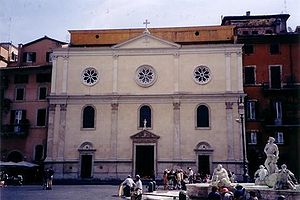
Nostra Signora del Sacro Cuore
Encyclopedia

Piazza Navona
Piazza Navona is a city square in Rome, Italy. It is built on the site of the Stadium of Domitian, built in 1st century AD, and follows the form of the open space of the stadium. The ancient Romans came there to watch the agones , and hence it was known as 'Circus Agonalis'...
.
History
An earlier church had been erected in the same place, on the ruins of the Stadium of DomitianStadium of Domitian
The Stadium of Domitian , also known as the Circus Agonalis, was located to the north of the Campus Martius in Rome, Italy. The Stadium was commissioned around 80 AD by the Emperor Titus Flavius Domitianus as a gift to the people of Rome, and was used mostly for athletic contests.- Construction and...
, in the 12th century. The new edifice was built for the Holy Year of 1450 by commission of Enrique of Castile, son of King Ferdinand III of Castile
Ferdinand III of Castile
Saint Ferdinand III, T.O.S.F., was the King of Castile from 1217 and León from 1230. He was the son of Alfonso IX of León and Berenguela of Castile. Through his second marriage he was also Count of Aumale. He finished the work done by his maternal grandfather Alfonso VIII and consolidated the...
. The façade, once facing the opposite side than now, was designed by Bernardo Rossellino
Bernardo Rossellino
Bernardo di Matteo del Borra Gamberelli , better known as Bernardo Rossellino, was an Italian sculptor and architect, the elder brother of the sculptor Antonio Rossellino...
. Pope Alexander VI
Pope Alexander VI
Pope Alexander VI , born Roderic Llançol i Borja was Pope from 1492 until his death on 18 August 1503. He is one of the most controversial of the Renaissance popes, and his Italianized surname—Borgia—became a byword for the debased standards of the Papacy of that era, most notoriously the Banquet...
, of Spanish origin, later had a square carved out in front of it.
Starting in 1506 the church was the national church of the Spanish nation in Rome. When Santa Maria in Monserrato degli Spagnoli
Santa Maria in Monserrato degli Spagnoli
The Spanish National Church of Santiago and Montserrat, known as Church of Holy Mary in Monserrat of the Spaniards is a Roman Catholic titulus church and National Church in Rome of Spain, dedicated to the Virgin of Montserrat. The current Cardinal Priest of the Titulus S...
was completed in the 17th century, the focus of the Spanish community shifted to that church, which is now the Spanish national church.
Pope Leo XIII
Pope Leo XIII
Pope Leo XIII , born Vincenzo Gioacchino Raffaele Luigi Pecci to an Italian comital family, was the 256th Pope of the Roman Catholic Church, reigning from 1878 to 1903...
had the edifice, which was on the verge of crumbling down, extensively renovated in the late 19th century. At that time the main entrance was moved to face Piazza Navona. The apse and the transept were demolished in 1938 to open the current Corso del Rinascimento avenue.
Interior
Most of the works of art and funerary monuments in the church were transferred to Santa Maria in Monserrato. What remains in the church are some Renaissance works, such as a chancel in polychrome marble and the marble backdrop behind the high altar.The Cappella di San Giacomo is also intact.

